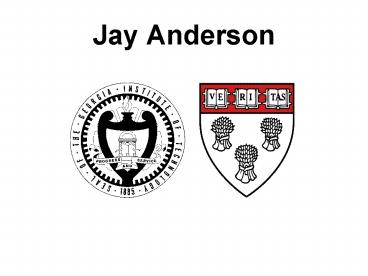Jay Anderson - PowerPoint PPT Presentation
Title:
Jay Anderson
Description:
Jay Anderson Jay Anderson (continued) 4.5th Year Senior Major: Computer Science Minor: Pre-Law Interests: GT Rugby, Claymore, Hip Hop, Trance, Drum and Bass ... – PowerPoint PPT presentation
Number of Views:115
Avg rating:3.0/5.0
Title: Jay Anderson
1
Jay Anderson
2
Jay Anderson (continued)
- 4.5th Year Senior
- Major Computer Science
- Minor Pre-Law
- Interests GT Rugby, Claymore, Hip Hop, Trance,
Drum and Bass, Snowboarding etc.
3
CURE
- An Efficient Clustering Algorithm for Large
Databases - Sudipto Guha Rajeev Rastogi Kyuseok Shim
presented by Jay Anderson
4
Agenda
- What is clustering?
- Traditional Algorithms
- Centroid Approach
- All-Points Approach
- CURE
- Conclusion
- QA
5
What is Clustering?
- Clustering is the classification of objects into
different groups. - Clustering algorithms are typically hierarchical
- Think iterative, divide and conquer
- or partitional
- Think function optimization
6
Traditional Algorithms
All-Points Based dmin, dmax
Centroid Based davg, dmean
7
The All-Points Approach
Any point in the cluster is representative of the
cluster.
dmin(Ca, Cb) minimum( pa,i pb,j )
dmax(Ca, Cb) maximum( pa,i pb,j )
dmin represents the minimum distance between two
points of a pair of clusters. Its counterpart,
dmax works similarly for divisive algorithms in
that the pair of points furthest away from each
determines who gets voted off the island.
8
The All-Points Example
Any point in the cluster is representative of the
cluster.
9
The Centroid Approach
Clusters as represented by a single point.
dmean(Ca, Cb) ma mb
davg(Ca, Cb) (1/nanb) Sa Sb pa pb
These distance formulas find a centroid for each
cluster. In identifying a central point, these
algorithms prevent the chaining by effectively
creating a radius for possible clustering from
the chosen point.
10
The Centroid Example
Clusters as represented by a single point.
11
Disadvantages
- Hierarchical models are typically fast and
efficient. As a result they are also popular. - However there are some disadvantages.
- Traditional clustering algorithms favor clusters
approximating spherical shapes, similar sizes and
are poor at handling outliers.
12
CURE
- Attempts to eliminate the disadvantages of the
centroid approach and all-points approaches by
presenting a hybrid of the two. - 1) Identifies a set of well scattered points,
representative of a potential clusters shape. - 2) Scales/shrinks the set by a factor a to form
(semi-centroids). - 3) Merges semi-centroids at each iteration
13
CURE(continued)
Choosing well scattered points representative
of the clusters shape allows more precision than
a standard spheroid radius.
a
Shrinking the sets, increases the distance from
each cluster to any outlier, possibly the
distance beyond the threshold and, mitigating the
chaining effect.
14
CURE(Continued)
- Time Complexity O(n2 log n)
- O(n2) for low dimensionality
- Space Complexity O(n)
- Heap and tree structures require linear space
15
QA































